Exploring the rich history of Bucharest through a guided walking tour is an enchanting way to uncover the city’s architectural gems and cultural tapestry. Visitors can expect an immersive experience, delving into the captivating narratives that have shaped Romania’s vibrant capital. From the opulent Palace of Parliament to the striking University Square, each landmark reveals a unique chapter in Bucharest’s past – from the reign of Vlad the Impaler to the lasting impact of the communist dictatorship. What secrets lie behind the city’s streets, waiting to be discovered?
Key Points
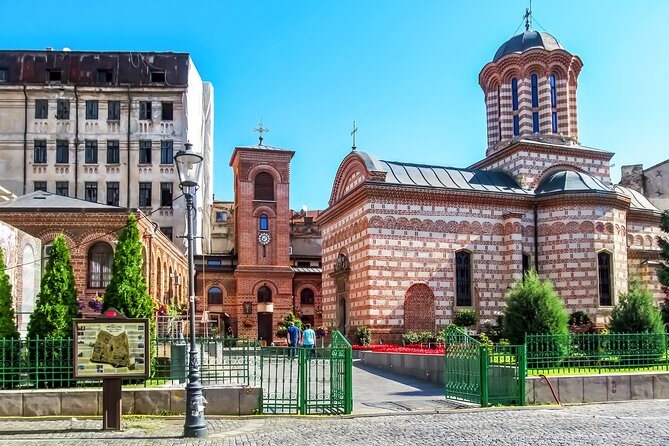
- Explore Bucharest’s diverse architectural styles, from grand neoclassical buildings to charming historical structures spanning centuries of history.
- Discover the legacy of Vlad the Impaler, the infamous 15th-century ruler who inspired the Dracula legend, and his connection to the city’s identity.
- Gain insights into the dramatic transformations of Bucharest during the communist dictatorship under Ceausescu and the lasting impact on the city’s built environment.
- Marvel at the neoclassical grandeur of University Square, the ornate Byzantine design of Kretzulescu Church, and the colossal Palace of Parliament.
- Understand how Bucharest’s tumultuous history has shaped its cultural heritage and the ongoing balance between preservation and modern development.
Overview and Duration
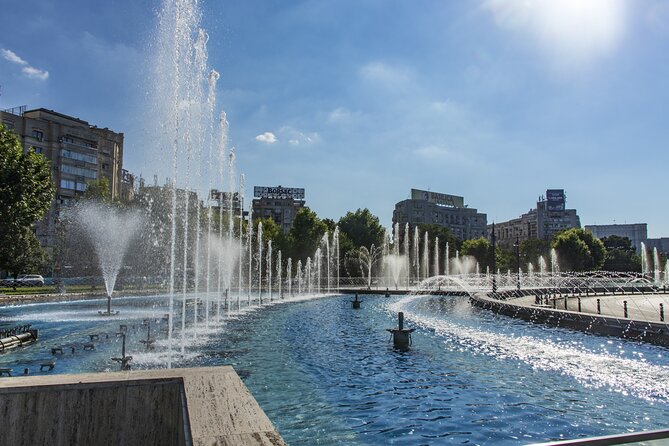
The walking tour of historical Bucharest takes guests on a 3-hour journey through the diverse and layered history of the city.
During this experience, visitors will discover the city’s iconic landmarks, including the impressive Palace of Parliament, the lively University Square, and the beautiful Kretzulescu Church.
The tour provides an in-depth look at the architectural styles that have shaped the city over the centuries, allowing guests to fully appreciate the rich cultural heritage of Bucharest.
Whether you’re a history buff or simply looking to explore a new destination, this guided walking tour offers a comprehensive and engaging way to experience the heart of Romania’s capital.
If you're enjoying exploring Bucharest on foot, you'll love these other walking tours we recommend
Highlights of the Tour
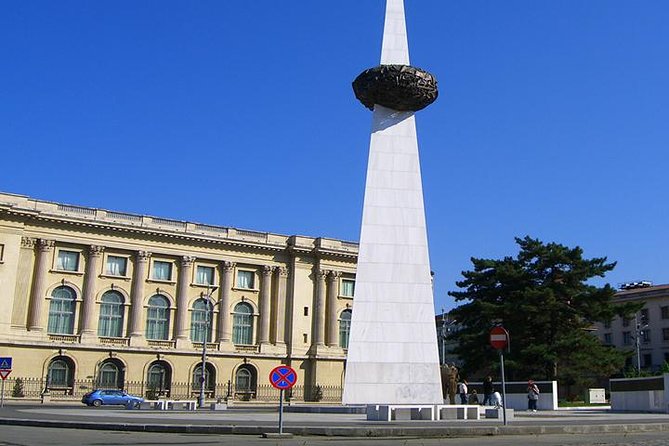
On this guided walking tour, visitors will admire Bucharest’s diverse architectural styles, ranging from grand neoclassical buildings to charming historical structures. They’ll also see the striking statue of Vlad the Impaler, the infamous 15th-century ruler whose brutal legacy inspired the Dracula legend.
On top of that, the tour explores how the city’s history was shaped by Ceausescu’s dictatorship and the Cold War era, providing insight into the country’s tumultuous past.
The highlights of this tour include:
- Discovering the city’s layered history, from its medieval roots to its communist-era legacy.
- Learning about the lasting impact of Ceausescu’s regime and the country’s transition to democracy.
- Gaining a deeper appreciation for Bucharest’s rich cultural heritage and architectural diversity.
Inclusions and Pickup
This guided walking tour includes a local guide who’ll provide valuable insights throughout the experience.
Visitors can either head directly to the meeting point or request pickup from their hotel, with pickup available outside the main entrance of Manuc’s Inn in the Old Centre of Bucharest.
The tour includes hotel pickup and drop-off for those staying at select hotels, making it a convenient option for travelers.
With the local guide leading the way, you will be able to learn about Bucharest’s diverse history and architecture in an engaging and informative manner.
The inclusions of this tour ensure a seamless and enriching experience for anyone interested in exploring the historical highlights of Romania’s capital city.
Cancellation Policy
Travelers can cancel their booking up to 24 hours in advance for a full refund, though changes made within 24 hours won’t be accepted.
The tour may also be canceled due to poor weather conditions.
Flexibility for last-minute changes – Travelers have the option to cancel their tour booking up to a day in advance without any penalties.
No changes within 24 hours – Modifications to the booking less than a day before the tour aren’t permitted.
Weather-related cancellations – The tour is subject to cancellation in case of unfavorable weather conditions that could impact the walking experience.
Architectural Styles of Bucharest
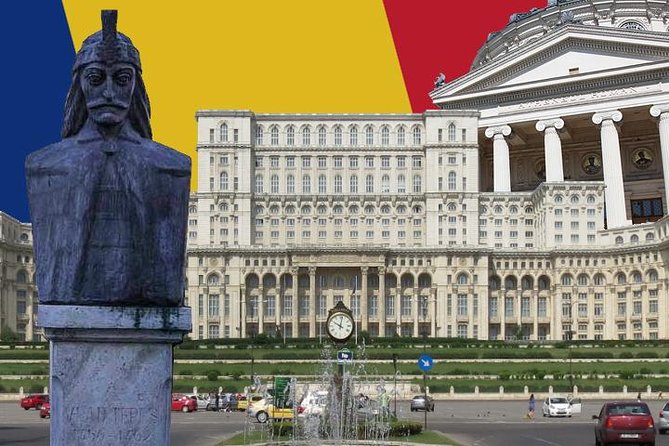
As visitors explore the historical streets of Bucharest, they’ll be captivated by the city’s diverse array of architectural styles, each reflecting the dynamic history and cultural influences that have shaped the Romanian capital over the centuries.
From the grandiose neo-Renaissance splendor of the Palace of Parliament to the charming Orthodox churches with their distinctive onion domes, Bucharest’s buildings showcase a captivating blend of influences.
The city’s eclectic mix includes Baroque, Neoclassical, and Art Nouveau structures, as well as the unique Romanian architectural style known as Brâncovenesc, which combines Byzantine, Renaissance, and Baroque elements.
This harmonious juxtaposition of old and new, East and West, makes Bucharest a truly fascinating destination for architecture enthusiasts.
Loving the local insights? Here are more guided experiences we recommend in Bucharest
- Bucharest to Dracula Castle, Peles Castle and Brasov Guided Tour
- Explore Bucharest Step by Step With A Local Guide
- 3 Days Private Guided Tour Including Transfagarasan Highway
- Bucharest: City Highlights Guided Private Tour 4h
- Bucharest: Old Town & Trendy Quarter Self-guided Walk
- 9-Day Private Guided Tour of Romania
Vlad the Impaler’s Legacy
No visit to Bucharest would be complete without a nod to the infamous Prince Vlad Dracul, whose brutal legacy continues to captivate visitors. Vlad the Impaler, as he’s more commonly known, was a 15th-century ruler whose horrific methods of execution, including impalement, earned him a reputation as one of history’s most ruthless leaders.
Despite his infamy, Vlad is celebrated in Bucharest for his fierce defense of the city against the Ottoman Empire. This complex legacy is evident in the statue depicting him in the heart of the city’s Old Town. As you wander the streets, you’ll encounter remnants of Vlad’s reign that serve as a sobering reminder of Bucharest’s tumultuous past.
Vlad’s ruthless actions, while brutal, were seen as necessary to defend his homeland against the expansionist Ottomans.
The Impaler’s legacy has become intertwined with the Gothic horror story of Bram Stoker’s ‘Dracula,’ further cementing his place in popular culture.
Visiting Vlad’s statue offers a chance to reflect on how a leader’s most infamous actions can also become integral to a city’s identity.
Impact of Dictatorship and Cold War
The legacy of Romania’s communist dictatorship and the Cold War era has left an indelible mark on Bucharest’s architectural landscape and urban development.
During the decades of totalitarian rule, the city underwent dramatic transformations as Ceausescu’s regime sought to reshape the capital into a showcase of socialist might. Grandiose structures like the colossal Palace of Parliament stand as monuments to this era, while the destruction of historic neighborhoods to make way for austere, uniform apartment blocks reflects the regime’s disregard for cultural heritage.
Even today, the city grapples with the aftermath, balancing preservation efforts with the need for modern development. This complex history is a central part of the walking tour, offering insight into Bucharest’s tumultuous past.
Exploring the City’s Landmarks
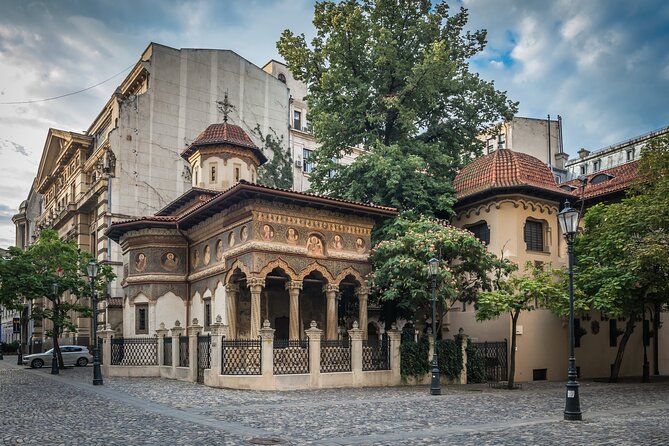
Visitors on the guided walking tour will marvel at Bucharest’s diverse architectural styles, from the neoclassical grandeur of University Square to the ornate Byzantine design of Kretzulescu Church. The tour takes guests past the colossal Palace of Parliament, a testament to the megalomania of former dictator Nicolae Ceaușescu.
Along the way, they’ll encounter the imposing statue of Vlad the Impaler, the 15th-century prince whose bloodthirsty reputation inspired the Dracula legend.
The tour offers insights into how Bucharest’s history has shaped its built environment:
- The scars of communist rule are visible in the monotonous apartment blocks and vast, empty plazas.
- The resilience of the city’s cultural heritage shines through in the surviving historic churches and mansions.
- The emerging modernity of Bucharest can be seen in the sleek, contemporary architecture that’s gradually transforming the cityscape.
Frequently Asked Questions
Is a Bathroom Break Included During the Tour?
The tour details do not specify whether a bathroom break is included. However, it’s likely the guide will accommodate participants’ needs during the 3-hour walking tour, as is typical for this type of activity.
Can We Stop for Lunch or Refreshments on the Tour?
The tour does not include scheduled stops for lunch or refreshments. However, your guide can provide recommendations for places to grab a bite or drink along the way, allowing you to explore the city at your own pace.
Is the Tour Offered in Any Languages Other Than English?
The tours are offered in multiple languages, including English, Romanian, French, and German. Guests can inquire about language options when booking to ensure they have a guide who speaks their preferred language.
How Much Walking Is Involved, and Is It Suitable for All Fitness Levels?
The tour involves around 3 hours of walking, covering several kilometres. It’s suitable for most fitness levels, though some mobility is required as there are no seated breaks. Guests should wear comfortable shoes.
Can We Take Photos During the Tour, or Are There Any Restrictions?
Participants can take photos during the tour, though certain sites may have restrictions. The guide will provide guidance on photo opportunities and any limitations. It’s best to check with the guide at the start of the tour.
Recap
This guided walking tour offers an enriching exploration of Bucharest’s diverse architecture and profound cultural heritage.
Visitors can discover iconic landmarks, gain insights into the city’s tumultuous past, and enjoy the layered history that has shaped Romania’s vibrant capital.
With engaging commentary and a seamless experience, the tour provides a comprehensive introduction to Bucharest’s captivating blend of past and present.
More Walking Tours in Bucharest
More Tours in Bucharest
- Transylvania Tour: Dracula’s Castle, Peles Palace & Brasov
- Bucharest: tour in the Parliament in Italian+exterior visit with guide
- Private tour: departure Bucharest to Peles Castle, Bran and Brasov Old Town
- From Bucharest: A Day by the Black Sea Shared Group Tour
- Bucharest city tour by car
- Bucharest: private and exclusive Italian walking tour
More Tour Reviews in Bucharest
- Bucharest : Parliament, Village Museum & Ceauescu Mansion
- Small Group Tour to Mogosoaia Palace & Snagov Monastery
- Bucharest: Walking tour with Italian speaking guide for small groups
- Bucharest Tuk Tuk City Tour
- Bucharest: Old Town & Historical Landmark Guided Tour
- Bucharest: Dracula Castle, Peles Castle & Brasov Guided Tour
Not for you? Here's more things to do in Bucharest we have recnetly reviewed
- PREMIUM TOUR SMALL GROUP: Peles&Bran Castles&Brasov Day Trip
- From Bucharest: Bulgaria Private Day Trip with Guide
- Slavery in Romania,Myths and Truths on Gypsies, Walking Tour
- Museums and Galleries walking tour in Bucharest
- PREMIUM TOUR SMALL GROUP Bucharest-Constana: Coastal Escape
- Private tour to Bulgaria : Ivanovo Churches & Veliko Tarnovo
- Therme:Spa Day at the biggest oasis of RelaxationBucharest
- From Bucharest: Dracula’s Castle & Bear Sanctuary Adventure
- Bucharest: Hidden Gems 2.5-Hour Walking Tour
- Communist Museums Marathon: 3 museums and all transfers incl
- Bucharest: Arc de Triomphe & Village Museum Guided Tour
- Bucharest: Custom Souvenir Workshop
